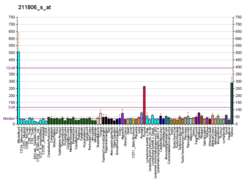KCNJ15
Potassium inwardly-rectifying channel, subfamily J, member 15,also known asKCNJ15is a humangene,which encodes theKir4.2protein.[5]
Function[edit]
Potassium channels are present in most mammalian cells, where they participate in a wide range of physiologic responses.Kir4.2is an integral membrane protein and inward-rectifier type potassium channel.Kir4.2has a greater tendency to allow potassium to flow into a cell rather than out of a cell. Three transcript variants encoding the same protein have been found for this gene.[5]
The existing literature describing KCNJ15 and Kir4.2 is sparse. In spite of some initial channel nomenclature confusion, in which the gene was referred to as Kir1.3[6]the channel was first cloned from humankidneyby Shuck and coworkers in 1997.[7]Shortly thereafter it was shown that mutation of an extracellularlysineresidue resulted in 6-fold increase in K+current.[8]Two years later, in 1999, voltage clamp measurements inxenopusoocytesfound that intracellular acidification decreased the potassium current of Kir4.2. Also activation of protein kinase C decreased the current although in a non-reversible fashion. Furthermore, it was found that coexpression with related potassium channelKir5.1,changed these results somewhat, which the authors concluded was likely to be a result of heterodimerization.[6]Further voltage clamp investigations found the exact pH sensitivity (pKa= 7.1), open probability (high) and conductance of ~25 pS.[9]In 2007 the channel was found to interact with theCalcium-sensing receptorin human kidney, using a yeast-two-hybrid system. This co-localization was verified at the protein level using bothimmunofluorescencetechniques andcoimmunoprecipitationof Kir4.2 and theCalcium-sensing receptor.[10]Also a mutational study of Kir4.2 has demonstrated that removal of a c-terminaltyrosineincreased the K+current more than 10-fold.[11]Because the channel has a very high open probability, the authors of this last article conclude that this increase is mediated by increased trafficking of the protein to the membrane and not increased single-channel conductance. This same line of reasoning is applicable to the initial work of Derst and coworkers.[8]
Interactions[edit]
KCNJ15 has been shown tointeractwithInterleukin 16.[12]
See also[edit]
References[edit]
- ^abcGRCh38: Ensembl release 89: ENSG00000157551–Ensembl,May 2017
- ^abcGRCm38: Ensembl release 89: ENSMUSG00000062609–Ensembl,May 2017
- ^"Human PubMed Reference:".National Center for Biotechnology Information, U.S. National Library of Medicine.
- ^"Mouse PubMed Reference:".National Center for Biotechnology Information, U.S. National Library of Medicine.
- ^ab"Entrez Gene: KCNJ15 potassium inwardly-rectifying channel, subfamily J, member 15".
- ^abPearson WL, Dourado M, Schreiber M, Salkoff L, Nichols CG (1999)."Expression of a functional Kir4 family inward rectifier K+ channel from a gene cloned from mouse liver".J. Physiol.514(3): 639–653.doi:10.1111/j.1469-7793.1999.639ad.x.PMC2269105.PMID9882736.
- ^Shuck ME, Piser TM, Bock JH, Slightom JL, Lee KS, Bienkowski MJ (1997)."Cloning and characterization of two K+ inward rectifier (Kir) 1.1 potassium channel homologs from human kidney (Kir1.2 and Kir1.3)".J. Biol. Chem.272(1): 586–593.doi:10.1074/jbc.272.1.586.PMID8995301.
- ^abDerst C, Wischmeyer E, Preisig-Müller R, et al. (1998)."A hyperprostaglandin E syndrome mutation in Kir1.1 (renal outer medullary potassium) channels reveals a crucial residue for channel function in Kir1.3 channels".J. Biol. Chem.273(37): 23884–23891.doi:10.1074/jbc.273.37.23884.PMID9727001.
- ^Pessia M, Imbrici P, D'Adamo MC, Salvatore L, Tucker SJ (2001)."Differential pH sensitivity of Kir4.1 and Kir4.2 potassium channels and their modulation by heteropolymerisation with Kir5.1".J. Physiol.532(Pt 2): 359–367.doi:10.1111/j.1469-7793.2001.0359f.x.PMC2278540.PMID11306656.
- ^Huang C, Sindic A, Hill CE, et al. (2007). "Interaction of the Ca2+-sensing receptor with the inwardly rectifying potassium channels Kir4.1 and Kir4.2 results in inhibition of channel function".Am. J. Physiol. Renal Physiol.292(3): F1073–F1081.doi:10.1152/ajprenal.00269.2006.PMID17122384.
- ^Pearson WL, Skatchkov SN, Eaton MJ, Nichols CG (2006). "C-terminal determinants of Kir4.2 channel expression".J. Membr. Biol.213(3): 187–193.doi:10.1007/s00232-006-0058-6.PMID17468958.S2CID7553004.
- ^Kurschner, C; Yuzaki, M (September 1999)."Neuronal interleukin-16 (NIL-16): a dual function PDZ domain protein".J. Neurosci.19(18): 7770–80.doi:10.1523/JNEUROSCI.19-18-07770.1999.PMC6782450.PMID10479680.
This article incorporates text from theUnited States National Library of Medicine,which is in thepublic domain.






